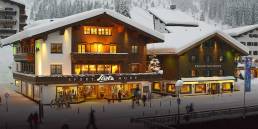The once-forbidding business of skiing is today draped in luxury. Pulitzer Prize winner David Shribman honors the audacity of Norwegian explorer Roald Amundsen, the man who made first tracks.
In the exploration logbooks, in the tales of the polar regions, in the archives of the audacious, names stand out: Cook. Peary. Shackleton. Scott. Franklin. But one stands alone, above the shivering crowd, at the front of the prow of the men who nudged their ships to the far frontiers of bravery.
Amundsen.
Perhaps the shiniest figure in the golden age of polar exploration, he was a skier, and even in that pursuit he sought out the terrain that was the most remote, the destinations the most demanding. He was a fearless seeker of challenge, a rugged roamer, wanderer, and trekker.
Born in frigid Norway in 1872 and reaching his demise—the death of the disappeared—in the dark waters of the Barents Sea 55 years later, Roald Amundsen was the personification of a long-ago ethos, replicated today only in guided tours and in inaccessible, unattainable reveries: Go farther, endure more, seek the faraway corners of the earth.
With a substantial inheritance that he plowed not into self-indulgence but into selfless exploration, Amundsen warmly embraced the cold air on both poles. As an obsessive pioneer and obsessive planner, he reached the North Pole and was first to the South Pole, all the while reaching new realms of human endurance.


The 1911 expedition to the South Pole represents the best of Amundsen. Weathered and wise, after an unsuccessful effort to reach the North Pole, he and the four Norwegian companions who comprised his team soldiered on in the last pursuit of earth’s unreachable terrain.
At first the Antarctic was a theory, with Greek philosophers—their instincts running to balance and their hypotheses anticipating the Newtonian notion of equals and opposites—conjuring a South Pole to offset the North Pole. These polar postulations hardened after Aristotle demonstrated that the earth was a sphere. At the end of the 18th century, Captain Cook’s second circumnavigation of the globe ventured south of the Antarctic Circle on a ship named, appropriately, Resolution. Once Peary achieved the great goal that Amundsen sought with resolution of his own—the North Pole, reached in 1909—attention inevitably turned to the other end of the world.
Scott was determined to be the first to reach the South Pole, and the smart money considered him good bet to do so. But when his crew stopped at Melbourne, Australia, he received a telegram: “Beg leave to inform you proceeding Antarctica, Amundsen.”
As the Amundsen party—equipped with sled dogs, not the ponies in the Scott retinue—neared its goal, it experienced unusually fine weather, marred only by slight snow showers from the southeast. Amundsen compared the approach to the Pole to “the eve of some great festival,” adding, “One could feel that a great event was at hand.” It was.
“We must, at all costs, get there first,” he said. “Everything must be staked on that.”
Amundsen’s party won the race, and the acclaim, only after great exertion in varying conditions—cold, wet snows and then unusual austral temperatures that reached as high as minus 16 Celsius.
In their pursuit, members of his team were forced to kill off some of their 52 sled dogs to provide meat to feed the surviving dogs. Finally, they arrived at their goal—neither the Promised Land nor land of promise—with three of their original four sledges and 17 dogs. Oscar Wisting, one of Amundsen’s most trusted companions, recalled how “together we planted Norway’s flag at the South Pole, where no human being had yet set foot.” It was three o’clock in the afternoon, the sun was shining and a photograph shows four men standing with the flag extended by the wind at nearly 90 degrees.
The goal was reached, the journey ended. I cannot say…that the object of my life was attained, that would be romancing rather too bare-facedly. I had better be honest and admit straight out that I have never known any man to be placed in such a diametrically opposition position to the goal of his desires as I was at that moment. The regions around the North Pole—well, yes, the North Pole itself—had attracted me from childhood, and here I was at the South Pole. Can anything more tipsy-turkey be imagined?
There was more to do, more to endure, miles to go before Amundsen would sleep in icy waters. His goal: reach the North Pole by air.
“Amundsen’s early success as an explorer was based primarily upon his mastery and adaptation of two historical traditions from different cultures—the Inuit use of dogs and light sleds, and the Scandinavian use of boots bound to wooden planks to travel over snow,” Brown wrote in his Amundsen biography, “But he was not nostalgic when he knew their time was over. He quickly perceived the advantages of air travel in exploring the frozen zones.”
So, from dogsleds to a dirigible he moved and, in 1926, on the airship Norge he passed over the North Pole. One of the passengers aboard was Italian aeronautical engineer Umberto Nobile who later, in 1928, crashed on the Arctic ice. Soon after, Amundsen set out to rescue him. His dirigible, apparently, crashed.
Soon thereafter, Bryden Sparkes, writing in Popular Science Monthly, captures the essence of the explorer.
“Amundsen! The very name carries the song of the Arctic winds; the musketry of the white places on the earth. Of all men, he alone had stood at both frozen tips of our spinning world. From boyhood, his life was dedicated to the lonely polar trails, and when, a weathered old man, he roared away into the white silence, on a winged quest of rescue, it was his beloved land of snow that claimed him at last.”
Amundsen’s body never was found.

Related Posts
December 11, 2019
Fast Forward-Lindsey Vonn Article & Photoshoot
What Lindsey Vonn has been up to since…




